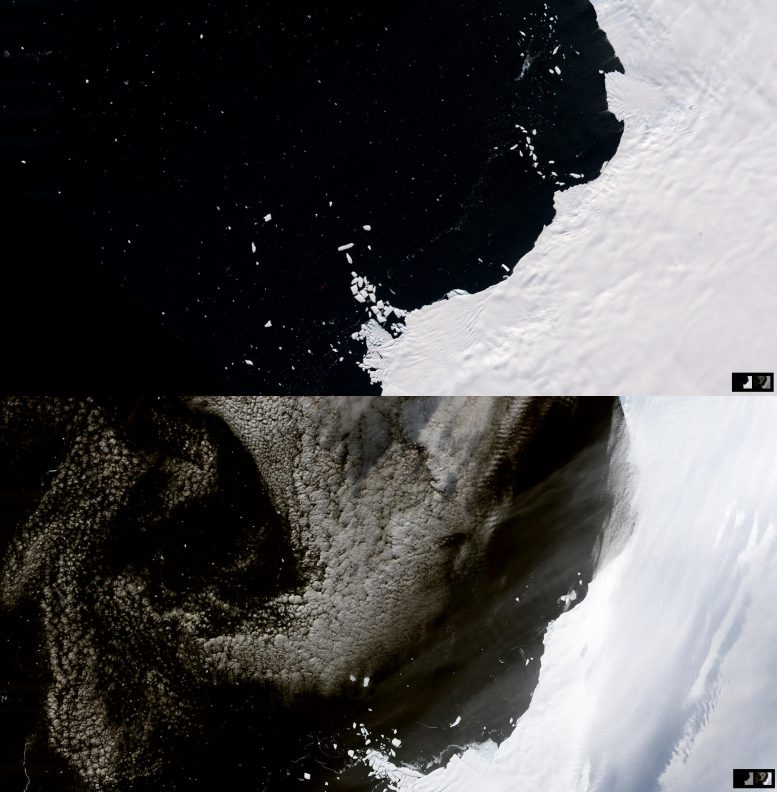
Before and After: Satellite images of shrinking glaciers along western Antarctica, from February 18, 1975 (top) to March 2, 2015 (below). Credit: NASA Earth Observatory
A recent theory illustrates the mechanism by which water underneath glaciers may surge — creating a dangerous feedback cycle.
Two Georgia Tech researchers, Alex Robel and Shi Joyce Sim, have collaborated on a new model for how water moves under glaciers. The new theory shows that the volume of water flowing beneath these ice masses into the ocean could be double previous estimates. This significant increase in subglacial water discharge might accelerate the melting of glaciers, contribute to rising sea levels, and prompt ecological disruptions.
Their research was recently published in the journal Science Advances.
While there are pre-existing methods to understand subglacial flow, these techniques involve time-consuming computations. In contrast, Robel and Sim developed a simple equation, which can predict how fast exfiltration, the discharge of groundwater from aquifers under ice sheets, using satellite measurements of Antarctica from the last two decades.
“In mathematical parlance, you would say we have a closed-form solution,” explains Robel, an assistant professor in the School of Earth and Atmospheric Sciences. “Previously, people would run a hydromechanical model, which would have to be applied at every point under Antarctica, and then run forward over a long time period.” Since the researchers’ new theory is a mathematically simple equation, rather than a model, “the entirety of our prediction can be done in a fraction of a second on a laptop,” Robel says.
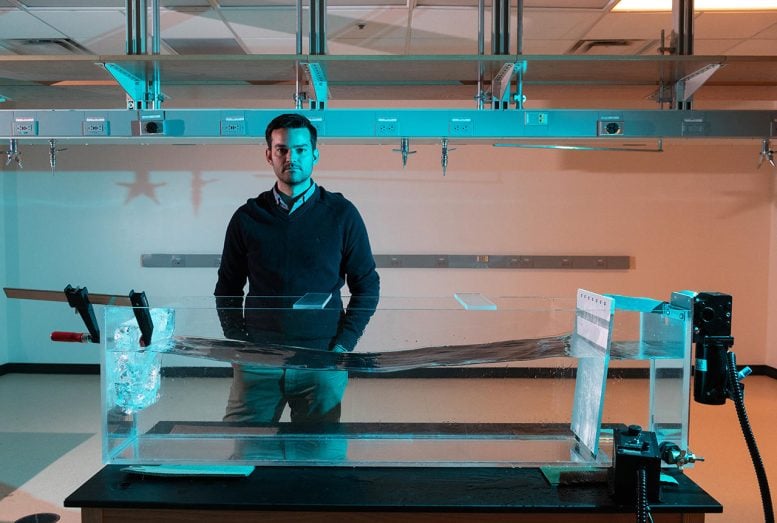
Alex Robel is an assistant professor in the School of Earth and Atmospheric Sciences at Georgia Tech. Credit: Georgia Tech (Allison Carter)
Robel adds that while there is precedence for developing these kinds of theories for similar kinds of models, this theory is specific in that it is for the particular boundary conditions and other conditions that exist underneath ice sheets. “This is, to our knowledge, the first mathematically simple theory which describes the exfiltration and infiltration underneath ice sheets.”
“It’s really nice whenever you can get a very simple model to describe a process — and then be able to predict what might happen, especially using the rich data that we have today. It’s incredible” adds Sim, a research scientist in the School of Earth and Atmospheric Sciences. “Seeing the results was pretty surprising.”
One of the main arguments in the paper underscores the potentially large source of subglacial water — possibly up to double the amount previously thought — that could be affecting how quickly glacial ice flows and how quickly the ice melts at its base. Robel and Sim hope that the predictions made possible by this theory can be incorporated into ice sheet models that scientists use to predict future ice sheet change and sea level rise.
A dangerous feedback cycle
Aquifers are underground areas of porous rock or sediment rich in groundwater. “If you take the weight off aquifers like there are under large parts of Antarctica, water will start flowing out of the sediment,” Robel explains, referencing a diagram Sim created. While this process, known as exfiltration, has been studied previously, focus has been on the long time scales of interglacial cycles, which cover tens of thousands of years.
There has been less work on modern ice sheets, especially on how quickly exfiltration might be occurring under the thinning parts of the current-day Antarctic ice sheet. However, using recent satellite data and their new theory, the team has been able to predict what exfiltration might look like under those modern ice sheets.
“There’s a wide range of possible predictions,” Robel explains. “But within that range of predictions, there is the very real possibility that groundwater may be flowing out of the aquifer at a speed that would make it a majority, or close to a majority of the water that is underneath the ice sheet.”
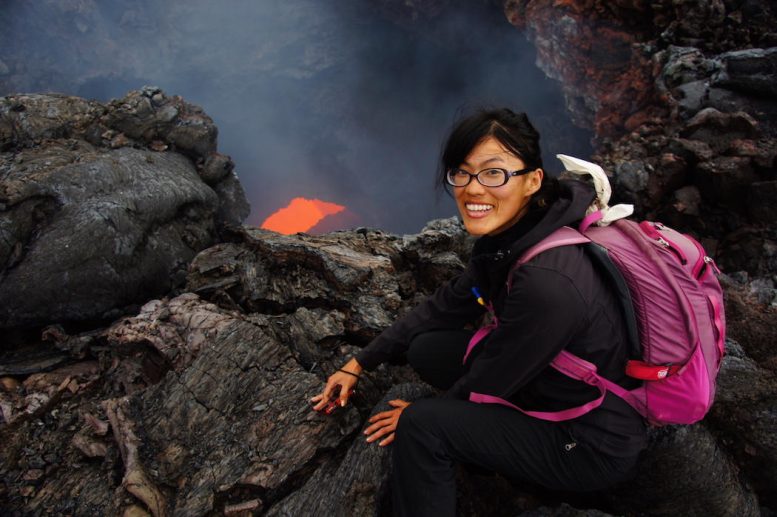
Shi Joyce Sim is a research scientist in the School of Earth and Atmospheric Sciences at Georgia Tech. Credit: Georgia Tech (Shi Joyce Sim)
If those parameters are correct, that would mean there’s twice as much water coming into the subglacial interface than previous estimates assumed.
Ice sheets act like a blanket, sitting over the warm earth and trapping heat on the bottom, away from Antarctica’s cold atmosphere — and this means that the warmest place in the Antarctic ice sheet is at the bottom of a sheet, not on the surface. As an ice sheet thins, the warmer underground water can exfiltrate more readily, and this heat gradient can accelerate the melting that an ice sheet experiences.
“When the atmosphere warms up, it takes tens of thousands of years for that signal to diffuse through an ice sheet of the size of the thickness of the Antarctic ice sheet,” Robel explains. “But this process of exfiltration is a response to the already-ongoing thinning of the ice sheet, and it’s an immediate response right now.”
Broad implications
Beyond sea level rise, this additional exfiltration and melt has other implications. Some of the places of richest marine productivity in the world occur off the coast of Antarctica, and being able to better predict exfiltration and melt could help marine biologists better understand where marine productivity is occurring, and how it might change in the future.
Robel also hopes this work will open the doorway to more collaborations with groundwater hydrologists who may be able to apply their expertise to ice sheet dynamics, while Sim underscores the need for more fieldwork.
“Getting the experimentalists and observationalists interested in trying to help us better constrain some of the properties of these water-laden sediments — that would be very helpful,” Sim says. “That’s our largest unknown at this point, and it heavily influences the results.”
“It’s really interesting how there’s a potential to draw heat from deeper in the system,” she adds. “There’s quite a lot of water that could be drawing more heat out, and I think that there’s a heat budget there that could be interesting to look at.”
Moving forward, collaboration will continue to be key. “I really enjoyed talking to Joyce (Sim) about these problems,” Rober says, “because Joyce is an expert on heat flow and porous flow in the Earth’s interior, and those are problems that I had not worked on before. That was kind of a nice aspect of this collaboration. We were able to bridge these two areas that she works on and that I work on.”
Reference: “Contemporary ice sheet thinning drives subglacial groundwater exfiltration with potential feedbacks on glacier flow” by Alexander A. Robel, Shi J. Sim, Colin Meyer, Matthew R. Siegfried and Chloe D. Gustafson, 18 August 2023, Science Advances.
DOI: 10.1126/sciadv.adh3693
The study was funded by NASA headquarters.


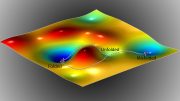



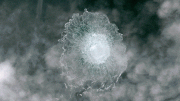
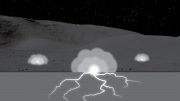

“Since the researchers’ new theory is a mathematically simple equation, rather than a model, …”
Even a simple equation is a model — albeit a simple model. While the author of the press release apparently doesn’t understand this, at least one of the authors demonstrates that she understands this when she says, “It’s really nice whenever you can get a very simple model to describe a process — and then be able to predict what might happen, especially using the rich data that we have today. It’s incredible.”